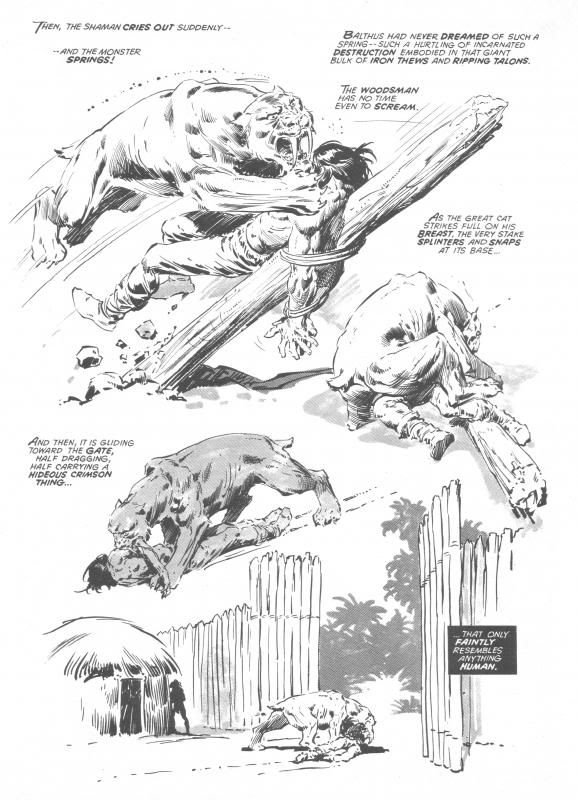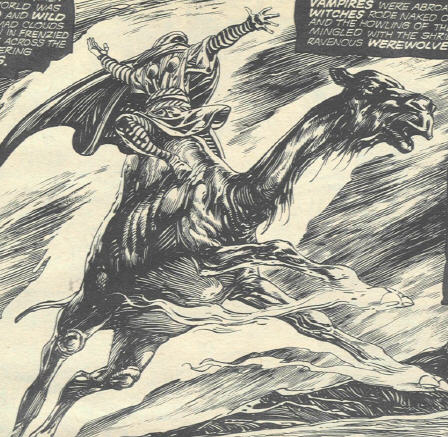As I've indicated, Robert E. Howard's original Conan tales border on being horror stories. Some may fully qualify as such. Howard, as already mentioned seemed to have a horror of apes, and ape-like beings and entities, as these often haunt the pages of his fiction. The "Ghost-Ape" story, "Shadow of the Beast," has already been mentioned, though a number of such creatures turn up in his Conan tales. Among the most famous is "Queen of the Black Coast,"in which Conan and his mate, Belit, queen of band of pirates, travel up the coast of Hyborian-age Africa (that continent is still mashed with Europe in Howard's fictional age). They encounter a brooding, eerie lost city, filled with treasure. The pirates fear the stash has some foul curse upon it, because of the strange winged shape seen haunting the ruins. They fear it is a "winged ape", and that it bodes ill for them all. But Belit is too greedy and plunders it anyway. But the slavering monstrosity who presides over the ruins seeks them out. At one point Conan is temporarily drugged into unconsciousness by the perfume of the Black Lotus. Under its spell, he experiences visions of an advanced civilization of winged man-like beings who flourished at the dawn, and how they were somehow unable to leave their city once the jungle overtook it. The race devolved into squalling madness over the centuries, culminating in a single abhorrent shape which still lurks among the crumbling stones.
Conan wakes to find Belit slain by the monster and hung by a jeweled necklace from the mast of the ship. Naturally, the barbarian is consumed by a rage for vengeance, which, this being a Howard Conan tale, he naturally accomplishes. In the his final showdown with the winged horror, the monstrosity nearly claims Conan's life, when Belit's ghost returns briefly from Arallu to fight by his side, distracting the brute, and allowing Conan to triumph. Some might recall a similar scene from the original Conan movie, with the warrior maid Valeria also returning the save Conan's life. The scene was lifted directly for "Queen of the Black Coast," just as the scene where a crucified Conan crushing a vulture to death with his teeth is taken directly from Howard's "A Witch Shall be Born."
"Queen of the Black Coast," was adapted to wonderful effect back in the seventies by writer Roy Thomas and artist John Buscema, as the pictures can testify. Recently, Dark Horse had a go at it, but to a lesser effect, compared to the 70s adaptation.
There is also the monstrous gray ape whom Conan battles in the dungeon in Hour of the Dragon, also called Conan the Conqueror, and the gray ape that nearly kills Conan in "Shadows in the Moonlight." Are these possibly the same species, a variety of ancient Hyborian flesh-eating ape-creature? Possibly they are, as these apes are particular to man-meat, as is the carnivorous ape in the non-Conan tale "Shadows in Zembabwe." The ape in this latter tale is described as having silver-gray fur, and a survival of the prehistoric ages, so perhaps it is a last survivor of Hyborian gray ape? In "Shadows in the Moonlight," Conan tells the rescued girl Olivia, after his near-fatal battle with the monstrous primate that "his kind dwell in the forests of the hills [on the mainland]...they are haunters of darkness and silent places."
Perhaps more famously for Conan is the tale "Rogues In the House." This features an ape-like monster named Thak, who is the "pet" of a priest, Nebonidus, aka the "Red Priest." Nebonidus has raised Thack as a cub, but has an adult the man-ape has turned on him, and the wizard is now a prisoner within his own palace. Thack roams within the twisting, labyrinthine, halls of the mansion.. He is, as Nebonidus explains to Conan and his companions, not a true ape, and sort of evolutionary transition between ape and man. Modern science might classify him as Australopithicus Robustus, or perhaps Homo Habilus; in any event some of man's early ancestral forms seem to have survived up into the Hyborian age. Eerily, Thack seems of near-human intelligence, and mimics his former master, in that he now wears the scarlet hooded cloak of Nebonidus; it's the same red cloak artist Frank Frazetta depicts him wearing in the famous painting of the story's climactic battle. A very similar red-cloaked man-ape showed up in the hall of mirrors in the movie Conan the Destroyer. That beast might have been a creation of Thoth Amon's sorcery, but writers Roy Thomas and Gerry Conway, though they wrote an entirely new story, were not above inserting some famous Howardian scenes.
In addition to the apes and ape-monsters which shamble monstrously throughout Howard's tales, a number of giant serpent-monsters slither through their pages as well. Howard seems to have shared with a large portion of humanity a horror of snakes. The two short horror stories "The Dream Snake," and "The Cobra in the Dream," depict serpents as the instruments of a character's demise, even when the victim is sound asleep. In the former tale, the narrator is found crushed by what seems to have been a gigantic phantom serpent, supposed until then to be a product of his imagination. Snakes of horrifying proportions also abound in the Conan tales. One type of monstrous serpent that turns up frequently is one Howard refers to in "Beyond the Black River" as "The Ghost Snake." This is a monstrous serpent of fifty feet plus, combining the worst aspects of the constrictor and the viper. The trunk of a ghost snake most resembles that of a monstrous python; but it also sprouts the venom-bearing fangs of its smaller, poisonous relatives. In "Black River," Conan aids some Aquilonian frontiersmen into the Pictish wilderness. 

Deep within the vast oak forest, an Aquilonian man named Balthus is captured by the Picts and forced to witness their strange midnight ceremonies. A Pictish shaman conducts rituals that summon beasts from the depths of the forest. The Pictish wilderness, by the way, is a vast forested realm whose depths no man of the Hyborian "civilized" world has ever plumbed. The creatures summoned from their black depths are monstrous survivals from earlier times. The first monster summoned is a saber-tooth cat, or smilodon, which, eerily, Howard describes as having a pale, ghostly coloration. The smilodon kills and bears off a hapless forester tied to a stake, at the shaman's will. Next, a gigantic white-colored "Ghost Snake" appears, summoned, apparently to swallow Baltus. But Conan manages to pierce the snake with an arrow, and it crushes several Pictish warriors in its death-throws.
A monstrous snake called Satha, which may well be a specimen of the Ghost Snake, makes an appearance to threaten Conan in "The Scarlet Citadel." The serpent is described by Howard as being a titanic eighty feet in length, with a head the size of a horse's, and pale scales the color of hoarfrost. Another monstrous serpent, also called Satha, appears in the Howardian epic "Valley of the Worm." This Satha, which the hero Niord manages to slay to obtain his venom, is suggested to be a survival of prehistoric times, and might well be synonomous with the prehistoric titanoboa, if not for his poisonous fangs. "The valley of the Worm," features Niord, (a prehistoric incarnation of invalid James Allison)a warrior of a nomadic warrior tribe, as they venture south into reeking southern jangles. Niord seeks revenge on the titular monstrosity, a Lovecraftian monster that presides over a lost city, for the death of his tribe (Niord's people made the fatal mistake of staying the night in the city). The monster Niord must slay is summoned forth,by a hair-covered, vaguely ape-like being playing an eerie piping on a strange instrument.
"Black Colossus" pits Conan against the sorcerer Thugra Khotan, who also has a bizarre, gibbering ape-like servitor, possibly a demonic entity, which is seldom glimpsed, save shambling into the wizard's tent at night, and driving the wizard's sorcerous chariot, which is pulled by a beast which appears to be a jet-black camel, but is really something otherworldly, as shown when the camel-beast sprouts wings in the distance, and soars into the sky.
There are many of Howard's Conan (and non-Conan horror) tales featuring horrific monsters and entities, though one more I want to make note of here, for the hour grows late. It is the entity that is the titular character in "The Black Stranger," which may be linked to the "dark man of the woods," also referenced in Irving's "The Devil and Tom Walker," and (I think) at least one of Hawthorne's tales. The figure of the Dark Man is a form of the devil in Irving, and though Irving describes being his protagonist as "neither Negro nor Indian," he seems linked inexorably with American racism. In the story, Conan and a band of pirates are searching for the treasure of Tranicos on the shores of the Pictish wilderness. Among them is a nobleman, Count Valenzo Korzetta, a man with a troubled past. When an innocent slave-girl blurts out that she has seen a "black man," on a boat riding on blue flame, Korzetta goes berserk, nearly whipping the girl to death, screaming that she is lying. Later, Korzetta grows morose, mumbling that he is doomed. He eventually confesses to the identity of the "black man" : no man at all, but a demon who he had summoned from beyond, and whom he later betrayed. Later, they hear a demonic drum pounding away in the deep of the forest, and storm soon ravages their encampment. The demon soon enters Korzetta's apartment, and has his revenge. When I first read this, it was in a greatly altered form, altered, in fact, by Conan anthologist L. Sprague DeCamp, who made it turn out that the "black man" was the sorcerer Thoth Amon, a character of his own, and fellow scribe Lin Carter's creation (you might know him form the comics and movies in particular). The original, which I was pleased to locate is MUCH darker, and very much more true to what Howard had in mind. Another, perhaps earlier version the story, "Swords of the Red Brotherhood," certainly as terrifying, was written as a straight, historical pirate yarn, this time with a self-exiled French nobleman pursued by a demonic entity. It was, perhaps later made into a Conan tale. UPDATE: The story "Swords of the Red Brotherhood," is, like all tales of Black Vulmea, set in historical times. This times, the "black man" IS human, an African sorcerer, who is betrayed, and sold into slavery by a greedy French nobleman. The tale plays out much like the Conan version, with the Frenchman meeting his end, and Vulmea securing the treasure, turning the feuding pirates against each other, and rescuing the Frenchman's daughter and her young friends, the two innocents caught up in this madness.
Back when I first discovered the real writings of the true Robert E. Howard, I was forced to search through paperback stores for years (and later, the New Howard reader and Donald Grant delux editions) to secure all of his weird fiction, Conan and otherwise. It's only now, years later that virtually all of his stuff, even the obscure fragments was made easily available in paper and hardback editions.







